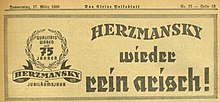Herzmansky
| Herzmansky
|
|
|---|---|
| legal form | GmbH |
| founding | 1863 |
| Seat | Vienna |
| Branch | retail trade |
The Herzmansky was a well-known department store in Vienna . It was founded by the merchant August Herzmansky in 1863. The department store was located at Mariahilfer Strasse 26–30 / Stiftgasse 3 in Vienna's 7th district, Neubau . Since 1998 a branch of Peek & Cloppenburg has been located in its place .
history
August Herzmansky (1834-1896) came to Vienna in 1848 from his hometown Odrau in what is now the Czech Republic and in 1863 founded a shop at Kirchengasse 7 that sold textiles . The original shop was at Stiftgasse 3. Alfred Gerngroß , a former employee of August Herzmansky, opened his own fabric shop under the name Gerngross in 1879 . After a brief competition, the two companies tried to work together, but this did not succeed, which is why this connection was dissolved again in 1881. Both Gerngroß and Herzmansky subsequently tried to establish a dominant commercial presence on Mariahilfer Strasse, Gerngroß starting from Kirchengasse and Herzmansky from Stiftgasse 1-3. Both companies successfully expanded with the concept that was then in progress in Europe's major cities: fixed price and high sales through a moderate premium. The " Warenhaus Herzmansky " expanded to Mariahilfer Strasse in 1892, and was built in 1897–1898 by the architect Maximilian Katscher (1858–1917). However, the founder of the business, August Herzmansky, did not live to see the opening, he died childless on December 5, 1896 and was buried in the Hadersdorfer Friedhof (section 2, no. 39).
The Herzmansky became the largest textile house in Austria-Hungary . According to its own advertising , the department store offered, among other things, " velvet ", plush , silk fabrics, woolen fabrics, laundry fabrics, lace, fashion goods and carpets. As a result, it had an eventful history with many changes of ownership.
After the company's founder died, his nephews Johann (1857–1924) and Eduard Herzmansky (1852–1911) took over the management of the company, but were not particularly successful at it. During this period Gerngroß established itself with a dominant Art Nouveau building (1904) on Mariahilfer Straße. In 1906 the nephews left and had Max Hegele build a monumental mausoleum at Hadersdorfer Friedhof (1909; Section 3, KAP, no. 201). The married Johann Falnbigl (1866-1932) took over the management and became a partner. Under Falnbigl there were larger extensions in 1908 and 1928. After Falnbigl's death on February 7, 1932, his son Wilfried took over the management for a short time, but left as a personally liable partner in 1933.
Max Delfiner managed the Herzmansky company as sole owner from 1933 to 1938. When Austria was annexed , there was an “ Aryanization ” in favor of the Dornbirn textile producers Rhomberg and Hämmerle , and the family had to emigrate. 1938–1940 the purchase of the house at Mariahilfer Strasse 30 led to an expansion of the sales area and the number of employees to 700 people at the time. There was considerable destruction in the Battle of Vienna in April 1945.
On November 8, 1948, the rightful owner Max Delfiner received his property back. His son Henry took over the management of the company. As early as 1957, however, the Delfiner family sold to the German Hertie group. He had larger parts of the building demolished and modernized up to the centenary in 1963 and beyond, but in turn sold in 1965 to a consortium of General Shopping SA, CA-Bankverein, Turicum AG, Interhansa and Durum AG. This consortium also acquired the Gerngross department store in 1966. In 1969 Gerngross and Herzmansky even merged under company law.
In 1971 the two department stores were sold again. A consortium with the Swiss department store group Jelmoli , Creditanstalt -Bankverein, Norddeutsche Landesbank and Internationale Treuhand AG acted as the buyer.
In the 1970s, the international department store crisis slowly made itself felt in Vienna as well. The mass motorization promoted the concept of the suburban shopping center with connection to expressways or motorways and an ample supply of parking spaces. As a result, it increasingly affected the classic inner-city business centers. The subway construction made Vienna's inner city more attractive, but the construction phase in Mariahilfer Strasse had to be a "dry spell". Nevertheless, on January 1, 1984, the union-related Konsum Austria took over the large department stores on Mariahilfer Strasse. From 1986 to 1988, the Herzmansky was converted into a “cosmopolitan department store” by 250 million schillings without closing times. These investments were not destined to be a commercial success. After decades of decline, Konsum Austria slid into insolvency, and in 1996 the Gerngross Group and with it Herzmansky went to a consortium made up of the Palmers textile group and Hans Schmid , the operator of the GGK advertising agency. While the Gerngross department store was reopened in February 1997 after renovation, the Herzmansky department store was closed on July 12, 1997.
The Herzmansky was sold to the Düsseldorf fashion chain Peek & Cloppenburg in 1998 . On March 4, 1998, Peek & Cloppenburg's first cosmopolitan building opened in the Herzmansky building. Since the name was no longer continued, the long history of the Herzmansky department store came to an end for the time being. Memorabilia and the bust of the founder, which used to adorn the foyer of the department store, are now kept in the Neubau district museum. In 2005 the Sparkassen Immobilien AG bought the majority of the Gerngross Kaufhaus AG from the Palmers Group. These include the Steffl and Herzmansky department stores . The founding building on Stiftgasse has been preserved from the outside in its original state, with the inscription “A. Herzmansky ”in the cornice framed in golden mosaics and clearly recognizable on the black marble panels on the ground floor area. Today there is an upscale cafe on the ground floor, operated by Cafe Gerstner .
photos
Advertisement in Die Muskete , 1912
literature
- A. Herzmansky warehouse in Vienna. Dipl. Arch. Maximilian Katscher in Vienna (plate no. 42). In: Wiener Bauten-Album , born in 1899, supplement to the “Wiener Bauindustrie-Zeitung”. XVI. Volume (1898/99), p. 14; Figure No. 42 . (Online at ANNO ). .
- A. Herzmansky department store: Herzmansky newspaper . Date of publication: September 1930 - December 1933 = No. 1–39. ZDB ID 2350675-1 . Herzmansky, Vienna, OBV .
- MA, Heinz Conrads (participant), Norbert Pawlicky (participant): Grosser Konzerthaussaal (…) September 17, 1963 (…) 100 years Herzmansky anniversary fashion show (…) . 1 sheet poster. Sn, s. l. 1967. - Online .
- Rudolf Matouschek, Lutz Wodak (executor): Herzmansky fashion show (…) Konzerthaus Grosser Saal (…) March 7, 1967 (…) spring fashion (…) . 1 sheet poster. Sn, s. l. 1967. - Online .
- Rudolf Hausner : Rudolf Hausner at Herzmansky, from June 19. Oil paintings, hand drawings, prints . 1 sheet poster. Sn, s. l. 1972. - Online .
- Herzmansky, August . Tagblattarchiv. (Press reviews). Two sheets. (Vienna) 1984, OBV .
- Siegfried Krupitz: 125 years of Herzmansky 1863-1988 . Gerngross Kaufhaus AG, Vienna 1988.
- Elfriede Faber: New building. History of the 7th district of Vienna and its old places . First edition. Edition Wien, Vienna 1995, ISBN 3-85058-065-2 .
- Andreas Lehne , Gerhard Meißl, Edith Hann: Viennese department stores 1865–1914 . Research and contributions to Vienna's urban history, Volume 20, ZDB -ID 716753-2 . Deuticke, Vienna 1990, ISBN 3-7005-4488-X .
- Peter Melichar: Displacement and Expansion: Expropriations and Provisions in Vorarlberg . Publications of the Austrian Commission of Historians, Volume 19, ZDB -ID 2135683-X . Oldenbourg Wissenschaftsverlag, Vienna 2004, ISBN 3-486-56783-7 , especially p. 107.
- Joseph Schwaighofer: On the history of the Viennese department store . In: Competitions. Architecture journal . No. 267/268, February / March 2008, ISSN 1015-4477 . Werba, Vienna 2008, p. 36 f.
- Pavel Kašpar st., Emil Mateiciuc: August Herzmansky z Oder, otec vídeňských obchodních domů . In: POODŘÍ - časopis obyvatel horní Odry 1/2013, pp. 36–46.
Web links
- Entry on August Herzmansky in the Austria Forum (in the AEIOU Austria Lexicon )
- wienschau.at - Department stores on Mariahilfer Straße, Herzmansky ( Memento from January 1, 2008 in the Internet Archive )
Individual evidence
- ↑ Maximilian Katscher. In: Architects Lexicon Vienna 1770–1945. Published by the Architekturzentrum Wien . Vienna 2007.
- ^ Peter Melichar : Displacement and Expansion: Expropriations and Provisions in Vorarlberg . Publications of the Austrian Commission of Historians, Volume 19, ZDB -ID 2135683-X . Oldenbourg Wissenschaftsverlag, Vienna 2004, ISBN 3-486-56783-7 , p. 107.
- ^ Elfriede Faber: New building. History of the 7th district of Vienna and its old places . First edition. Edition Wien, Vienna 1995, ISBN 3-85058-065-2 , p. 93.
- ↑ Wirtschaftsblatt.at | Herzmansky and Steffl sold
Coordinates: 48 ° 12 ′ 1 ″ N , 16 ° 21 ′ 20 ″ E








